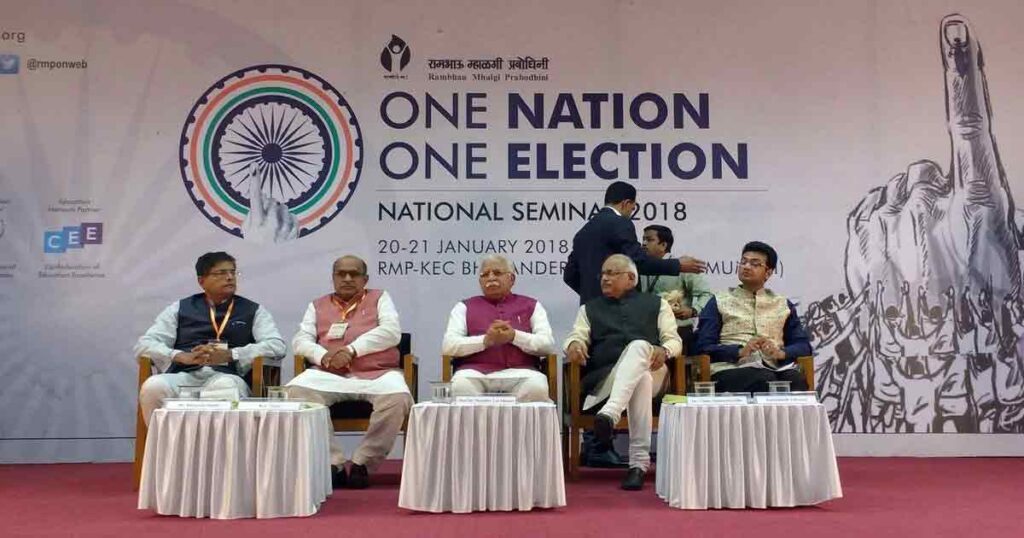“The ballot is stronger than the bullet” – Abraham Lincoln
The power of these words is immensely relevant in India, the largest democracy of the world. It has a Parliamentary System of government, with commitment to hold regular, free and fair elections. The Election Commission of India (ECI) is an autonomous constitutional authority responsible for administering election processes in India.
The ECI primarily categorizes the elections as General Elections (to constitute the Lok Sabha, electing members of Parliament across all 543 parliamentary constituencies of India) and Assembly Elections (to elect the members of Vidhan Sabha or State Assembly). Every 5 years the members are elected in both the categories of Lok Sabha and State Assembly but the dates are not synchronized.
In 2019, the states of Andhra Pradesh, Odisha, Arunachal Pradesh and Sikkim were the only states which held assembly elections simultaneously with the Lok Sabha elections.

Also Read: Vocal For Local: Big Boost For Indian Companies.
With almost 5 decades of conducting elections on different dates/ years as per the 5 years term for State Assemblies, it might be a Herculean task to synchronize the process to conduct simultaneous elections across the nation.
Table of Contents
Challenges of Conducting Simultaneous Elections
- Amendments to Constitution: In scenarios where the ruling state government loses majority and a no-confidence motion is suggested, there should be clear guidelines available to avoid midterm elections. Either an alternate government is formed or the no-confidence motion should be replaced with ‘constructive vote of no-confidence’. Else, the simultaneous election process will get disrupted. This is followed effectively in many countries like Israel, Indonesia, Germany, Spain, Poland and Belgium.
- Viability: The ECI should be equipped adequately to conduct elections across India which is a mammoth task. Feasibility in terms of logistics, security arrangements and additional human resources to be deployed to manage the elections has to be strategized. It will be a colossal one time expenditure on infrastructure like procurement of EVMs. A massive number of simultaneous polls have to be planned and executed with precision, especially for a heavily populous country like India.
- Influence on voting choices: Studies reveal that in the last few years people tend to vote differently for Assembly and Parliament elections. There is a hypothetical view that in the simultaneous election process the voters may choose the same party or its allies for both central and state, thus curtailing the choice of the voters.
Merits of Simultaneous Elections
- Cost effective: The topmost benefit of simultaneous election is the reduction in the cost incurred in conducting frequent elections.
Every year, the Central Government and/or respective State Governments bear expenditures to conduct elections.
The Lok Sabha election expense is borne by the Central Government. The State Assembly election expenditure, when conducted independently, is borne by the respective State Governments. When simultaneous election process is followed, the Central and State governments will be saving more by sharing the election expenditures.
- Continuity in development programmes: During elections the Model Code of Conduct comes into force which restricts the implementation of new projects and policies. Simultaneous elections will avoid the country from being in constant election mode and frequent disruptions of developmental work.
- Higher Voter turnout: According to the Law Commission of India Draft Report 2018 on Simultaneous Elections, “As simultaneous election will increase the voter turnout; it will demonstrate the vibrancy of political citizenship and civic spirit. The rise is evident in voter turnout in election in states like Andhra, Karnataka, Maharashtra, Kerala, Arunachal and Manipur when their state election coincided with national elections.”
One Nation, One Election is a successful model followed by many developed countries like Germany, Sweden, Spain, Belgium etc. The debatable point here is that these countries are not as populous as India and are well equipped in terms of economy, infrastructure and technology. However, even such developed nations have ensured that they follow a system of constructive vote of no-confidence, which avoids midterm dissolution of the ruling government.
While India may draw inspiration for conducting simultaneous elections from these nations, it is crucial that the spirit of democracy is upheld in following the process diligently. Moreover, for India, the sheer size and magnitude of the entire exercise is gargantuan and complex when compared to these countries. It may be more viable to study the simultaneous election model of countries like South Africa which has a similar demographic and economic profile like India.
Elections are pivotal to democracy and every citizen’s vote is valuable. India has witnessed many reforms when it comes to the election process and constitutional amendments to meet the evolving needs of the country. The introduction of EVMs was one such massive move. Similarly the ‘One Nation, One Election’ process is an enormous task that presently looks a mission impossible but is attainable.
There are many advantages to holding simultaneous elections with its own share of challenges. It is a demanding operation involving macro and micro level discussions, policy changes, electoral reforms and the humongous practical implementation of the synchronization process. In the current scenario, the need of the hour is greater deliberations, better understanding, consensual decision making followed by precise planning and seamless execution.
Follow us on Facebook, Twitter, Instagram, and YouTube to get more updates related to Sachi Shiksha – The Famous Spiritual Magazine in India. Also Read Our Hindi and Punjabi Editions.
















































